By Jeremiah Knupp and Holly Marcus // Photos by Holly Marcus
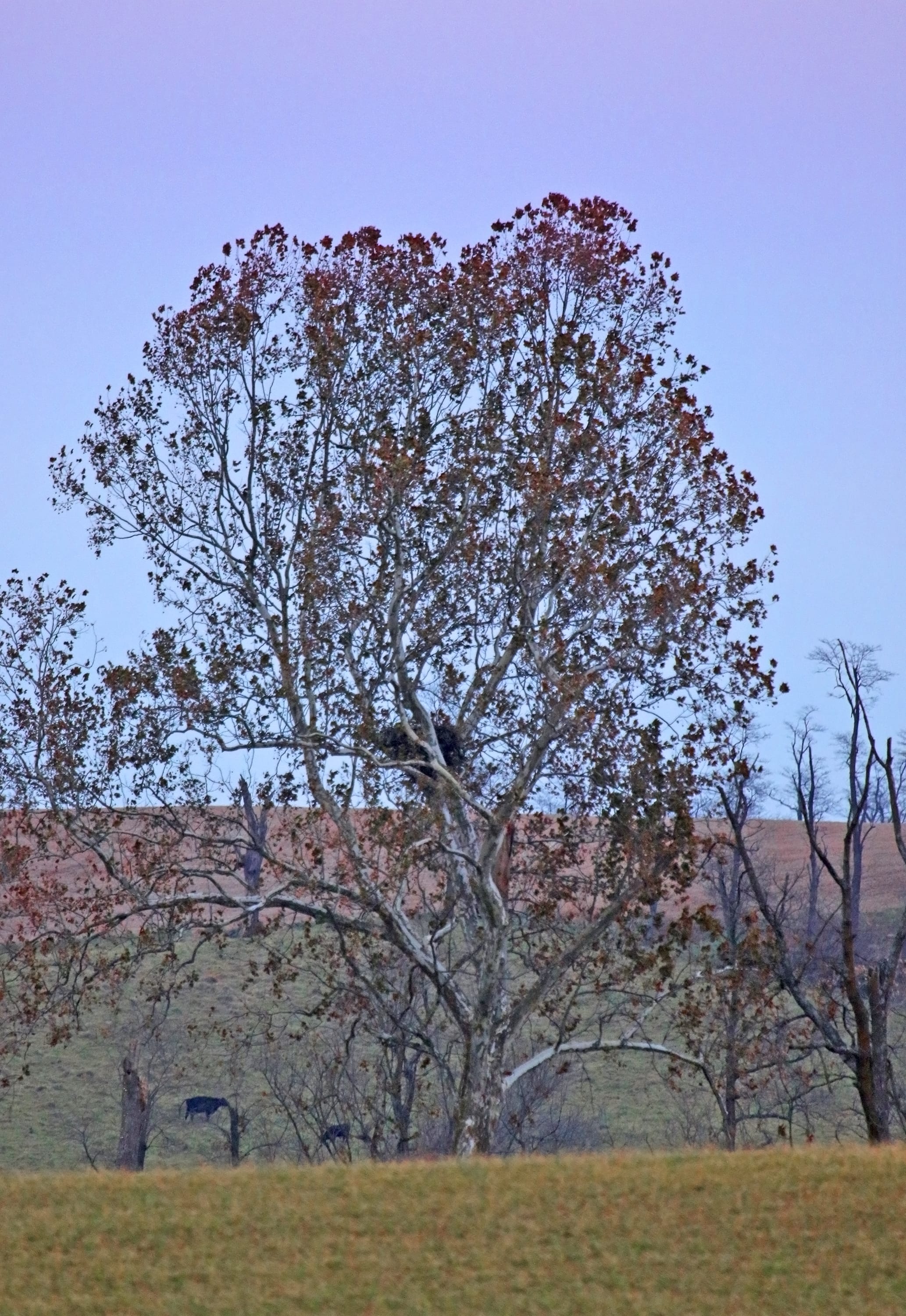
A bald eagle nest is cradled amongst the limbs of a sycamore tree west of Harrisonburg. Bald eagle pairs return to the same nest each year, adding sticks to build a massive structure that can weigh up to 1,000 lbs.
At 600 yards it’s difficult, at first, to get a perspective of the size of the nest hid in the center of a tree on the edge of a field near Singers Glen. The realization that the sycamore is probably at least 50 feet tall means the nest must be more than four feet across. A passing flock of geese disturbs the occupant of the gigantic tangle of sticks and grass. The bird takes flight, its wings unfolding to reveal an unmistakable white head and tail. The bald eagle flaps lazily, gaining altitude as it glides in an arc that takes it towards Little North Mountain.
At one time the sight of a bald eagle in the central Shenandoah Valley, much less a nest in the middle of pasture land, would have been a rare one. Now that they’re nesting less than eight miles, as the eagle flies, from downtown Harrisonburg, seeing a bald eagle on the wing over the city limits has become much more common – and testimony of the species’ successful return from the brink.
The story of the bald eagle’s decline is probably better known than its successful resurgence. At one time eagles were considered a nuisance, and the popular misconception that they preyed upon livestock led to an open season on the birds. Then, the 1940 Bald Eagle Protection Act outlawed the killing of eagles or disturbing their nests. In a few years, however, a more effective eagle killer than a shotgun blast arrived.
In the post-World War II era, the use of chemical pesticides like DDT became prevalent. Over-application led to chemical runoff into streams and waterways. Fish ingested the chemicals, and eagles ate the fish. In the eagles’ bodies, the DDT limited their ability to metabolize calcium, thinning the shells of their eggs and preventing successful incubation. By 1963 less than 500 nesting pairs of bald eagles remained in the United States and an early 1970s survey revealed only 33 pairs in Virginia. The United States’ national symbol was in danger of extinction.
In 1972 the use of DDT was banned. The Endangered Species Act became law in 1973 and in 1978 bald eagles were declared endangered. Recovery was slow at first. It took over a decade for the chemicals to work their way out of the ecosystem. But by the mid-1980s the eagle population was on the rebound.
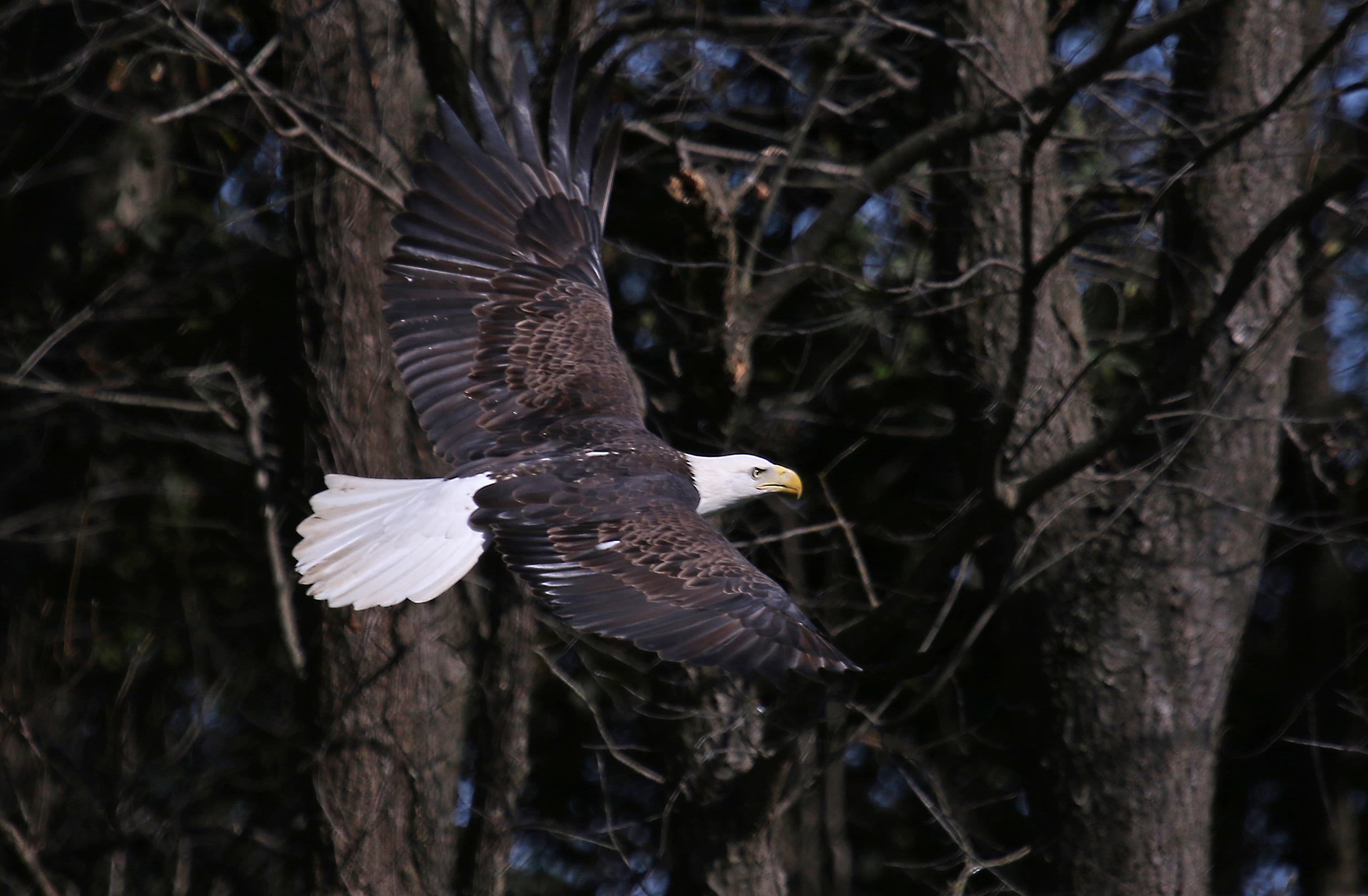
A bald eagle takes flight after scavenging a deer carcass along a road west of Harrisonburg in late October. Sightings of bald eagles in the Shenandoah Valley have increased more recently as the eagle population has been making a resurgence in the state over the past few decades.
The Waynesboro-based Wildlife Center of Virginia is one of the leading bald eagle conservation organizations in the country. It opened in 1982, and got its first bald eagle patient in 1985. Among the center’s first efforts was to identify carbofuran insecticides as poisoning eagles in the state.
“By that time there was a huge conservation effort underway to save our national symbol from extinction,” said Ed Clark, Wildlife Center founder and its current president. “We were the first to identify this chemical Furadan as poisoning bald eagles. We eventually got Virginia’s law changed and got this chemical banned in the state.”
In 1995 the bald eagle was taken off the endangered species list and by 2007 it was no longer considered “threatened.” An estimated 10,000 nesting pairs are now present in the continental U.S.; of those, 2,000 are in the Chesapeake Bay region.
“All of us who were concerned about bald eagle populations were afraid that the population would reach a certain point, at which all the primary habitat would be filled and then there would be no more nesting territory. As that habitat diminished or developed or degraded in one way or another, our prediction at the time was that the bald eagle population would then go back down,” Clark said. “What we did not figure on is that the bald eagle population continues to grow and they just move into new habitat – habitat that is not really, frankly, ideal. That includes the Shenandoah Valley.”
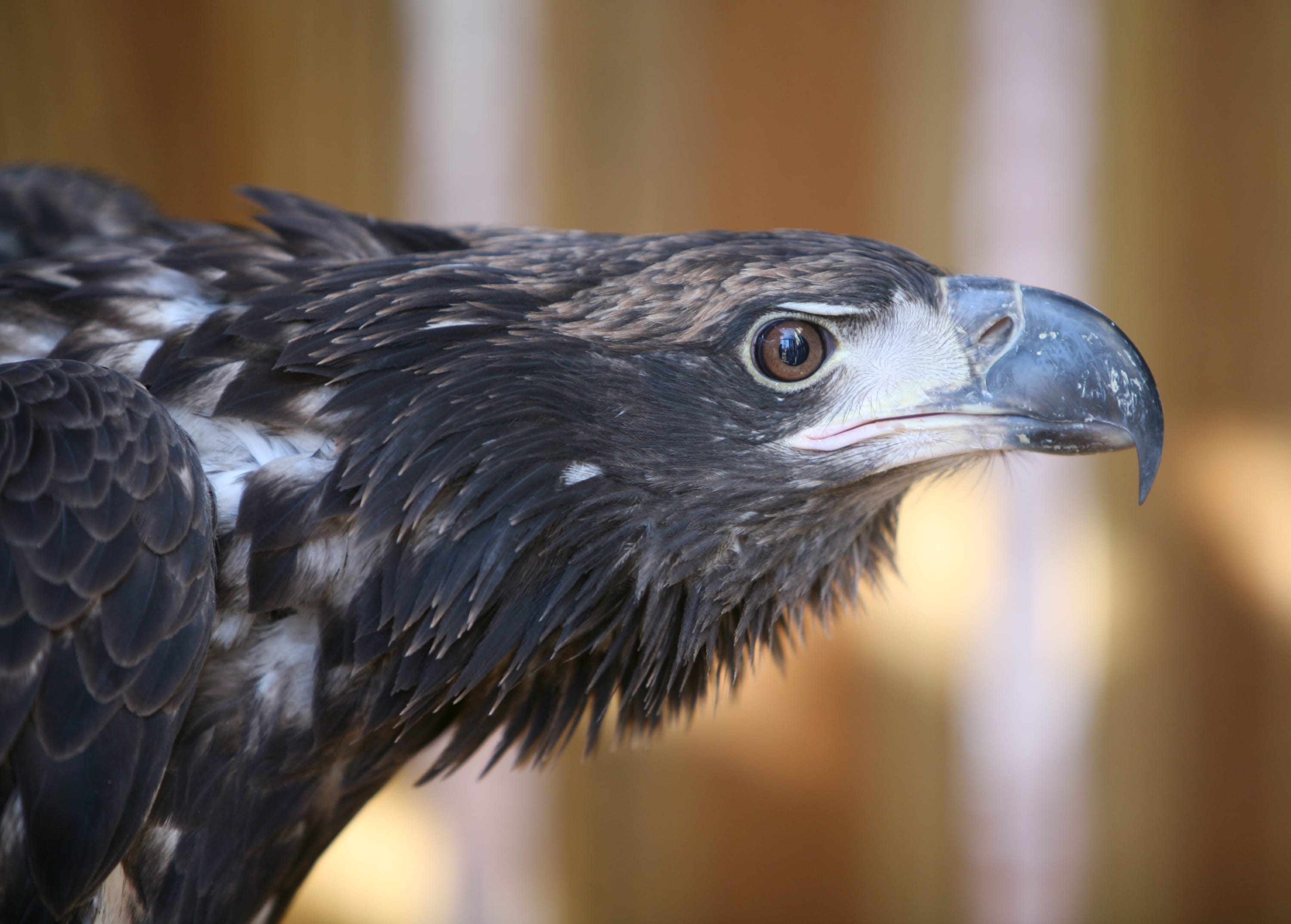
This juvenile bald eagle became a permanent resident at the Wildlife Center of Virginia due to a broken wing that did not heal properly, disabling her from flying in this photo from 2008. It takes 4 to 5 years for a juvenile bald eagle to develop its distinctive white head.
Bald eagles mainly eat fish and prefer the abundant pickings of the Chesapeake Bay and adjoining tidal rivers – an area that Jeff Cooper, a wildlife biologist with the Virginia Department of Game and Inland Fisheries (VDGIF), says has one of the densest eagle populations in the continental U.S. The new presence of resident eagles in the Valley is an indication that the state’s eastern population is thriving and expanding to the west.
“As the coastal plains get saturated there is only so much room. You start getting birds that mature and start venturing out and pioneering into other areas,” said Cooper, the department’s non-game bird project manager, who specializes in raptors. “That’s probably what’s occurring. There are probably breeding pairs in every county of Virginia.”
A 2009 aerial survey by the VDGIF found eagle nests every five to 12 miles along both the North and South Forks of the Shenandoah River. Local data gathered by bird watching clubs has also documented the eagles’ return. The Rockfish Gap Hawk Watch, a volunteer count that takes place from August to November on Afton Mountain, saw zero bald eagles when the count started in the mid-1970s. By the mid-1980s they were seeing less than a dozen. By 2010 that rose to more than 100 eagles. Last year, a record 329 bald eagles were spotted.
“In the Valley you have the Shenandoah River fisheries resource. You have roadkill deer and in the winter in particular bald eagles feed on a lot of carrion. So there is obviously a food source to support a small population,” Cooper said. “One thing that we’ve started to see is eagles nesting in urban and suburban situations. They’re starting to become more and more habituated to human presence.”
In Rockingham County the eagles have moved beyond the main branches of the Shenandoah River and up tributaries like Dry River, to flood control reservoirs and into farm country. As local residents begin to encounter eagles some of the old myths still persist.
“Some people still think bald eagles kill livestock. Usually the case is that the livestock died or was killed by something else and they exploit the dead carcass,” Cooper said.
“Eagles pose almost no risk to pets whatsoever,” said Clark. “There are a lot of stories out there, and Facebook gets them every now and then, but the stories don’t hold water. An average-sized adult male eagle weighs about eight pounds in Virginia. They can’t carry more than about a third of their body weight. If you look at the average cat weighing 12 to 15 pounds an eagle can’t lift it.”
“We get this mentality that predators are bad animals as opposed to deer fawns which are good animals,” Clark added. “It’s a projection that a predatory animal is mean or aggressive because it kills other animals as a food source. That’s just silly.”
Nonetheless, negative encounters between man and eagle still occur. In September of this year an injured eagle was found along Interstate 81 in Rockingham County just outside the Harrisonburg city limits that was suffering both a gunshot wound and injuries from collision with a vehicle. The eagle died on its way to the Wildlife Center. The penalty for harming an eagle or their nest is a maximum fine of $5,000 and up to a year in prison.
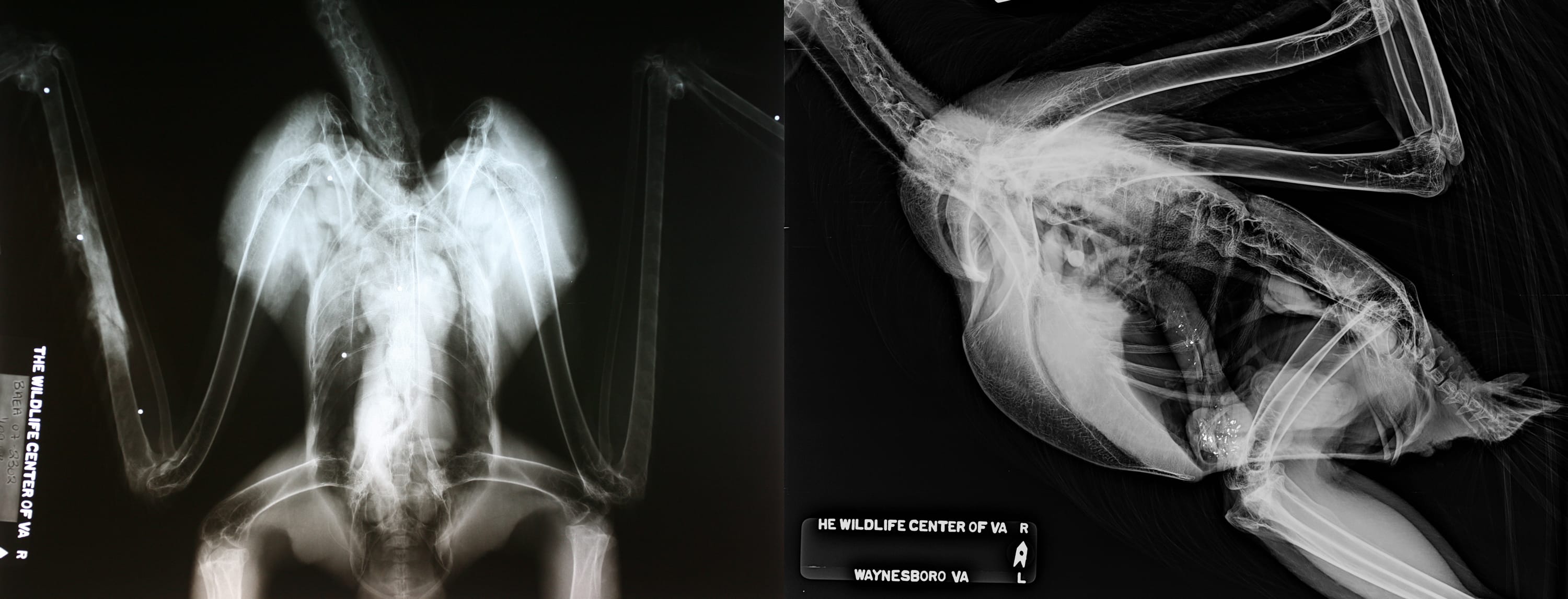
X-rays from the Wildlife Center of Virginia show (left) a bald eagle that suffered injuries from a shotgun blast, the small lead pellets showing up as white dots, and (right) an eagle that entered the center that had ingested lead fragments from feeding on carcasses that were shot using lead ammunition and thus suffering from lead poisoning, the lead is visible as small white speckles. Courtesy of The Wildlife Center of Virginia
Overall, Clark believes, the interaction between eagles and area residents have been positive.
“If you’ve got eagles in the area it’s a good omen. It’s a sign that you’ve got something right about your property and that things are going well and most people take it that way,” Clark said. “By in large I think people are as pleased as pie to see eagles.”
Though the threat of DDT is behind them, eagles still face challenges in the Valley.
“The population has moved from the Tidewater area of Virginia, first across the Piedmont and now across the mountain and into the Valley,” Clark said. “That has brought us an entirely new conservation challenge with bald eagles. What we’re facing now is not agricultural chemical poisoning. We’re facing bald eagles that have moved out of the fish area where they can support themselves with an aquatic diet. Now they are scavenging. We’re getting a lot of them that are picking up toxic substances at landfills. We’re getting them hit by cars because they’re eating roadkill, but the biggest problem that we are seeing right now in Virginia with bald eagles is lead poisoning. That is coming from the ingestion of remains of animals that have been killed by hunters.”
When hunters shoot game with bullets containing lead, fragments may remain in the internal organs that are disposed of after processing the carcass. When the eagles scavenge these remains they ingest the lead, compromising their nervous system and eyesight. If this doesn’t kill them outright, it predisposes them to other early fates. Eagles that can’t see to hunt, for example, scavenge, which leads to collisions with cars.
“Last year we admitted 55 bald eagles at the center. It shattered previous records,” Clark said. “The good news is we’ve got more eagles in Virginia. The bad news is they’re coming in [to the Wildlife Center] from places away from large bodies of water and of those 55 eagles, 72 percent of them had measurable lead in their bloodstream and half of those had lead poisoning as the injury that brought them to be hospitalized.”
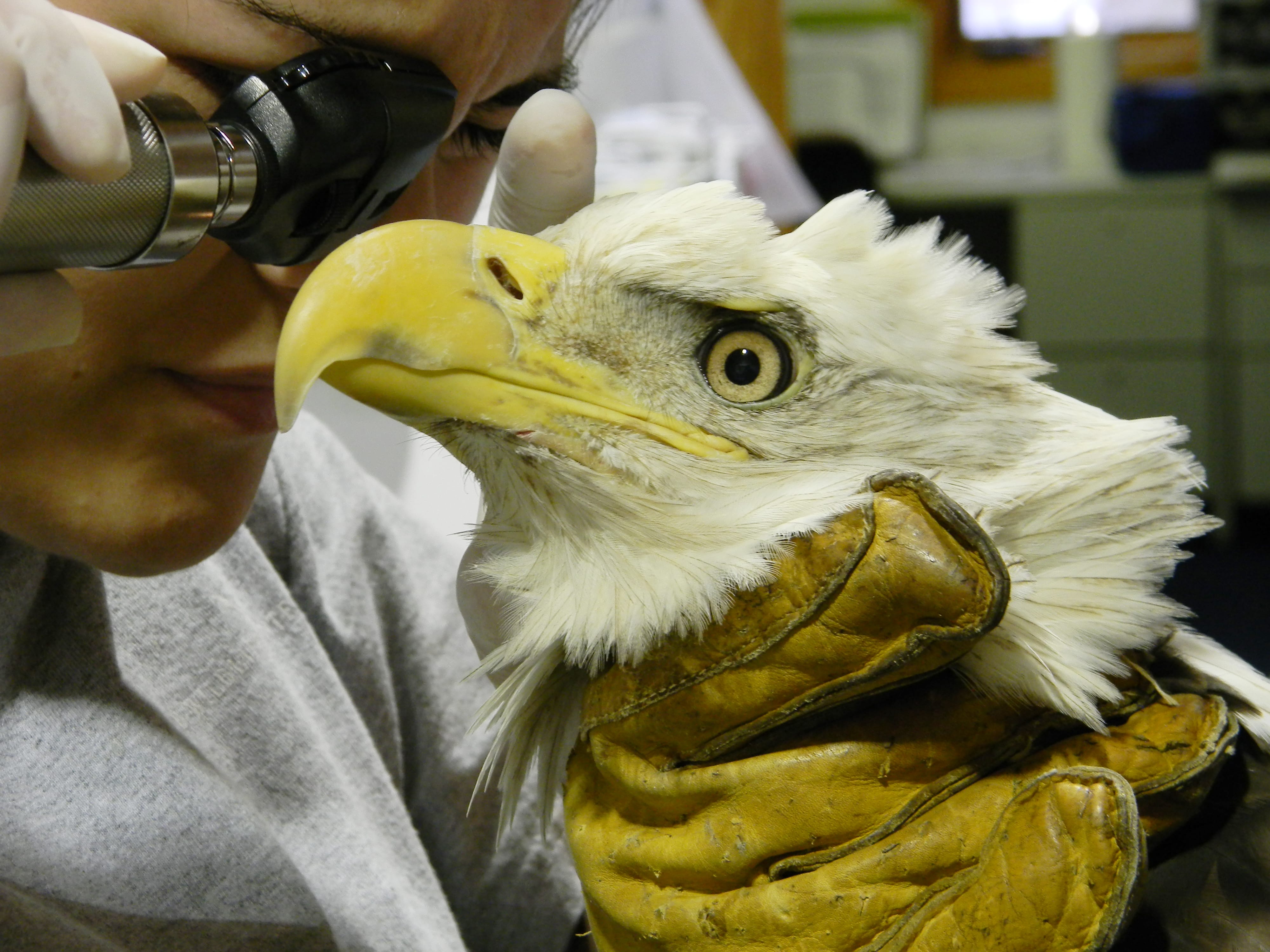
The Wildlife Center of Virginia has already received 44 bald eagles from around the state at its location in Waynesboro. Courtesy of The Wildlife Center of Virginia
As of November 5, the Wildlife Center had already admitted 44 bald eagles this year, including five from Rockingham and its adjacent counties.
“Part of our big initiative is that we are working with hunting groups to encourage those that enjoy hunting to switch to alternative ammunition that does not contain lead,” said Clark, who himself grew up hunting in Virginia and noted that a fragment of lead as small as a grain of rice is enough to kill or disable an eagle. “It’s about getting people who pursue traditional sports to entertain non-traditional ideas.”
It’s a timely message, as the general deer hunting season in Rockingham and the surrounding counties opens on Saturday. Clark recommends that hunters who use lead bullets recover all the game they shoot, remove it out of the field and cover the entrails with brush to keep it away from scavenging birds. But even the problem of lead poisoning is a sign of the eagle population’s successful recovery.
“It’s not one of the reasons that eagles were originally endangered. It’s because we’ve succeeded in bringing back the bald eagle. That’s the good news. The bad news is that there is not enough aquatic habitat so they are eating contaminated food sources,” Clark said. “It’s a good news/bad news story. We brought the national symbol back from extinction. It would have been a tragedy to have lost our iconic wildlife species. It’s such an iconic symbol of power and greatness. They’re used for everything from beer logos to football teams to the highest award in scouting and every flag pole in the country has an eagle sitting on top of it. We needed to bring it back.”
By all indication it seems American’s bird will continue to have a permanent presence in the Shenandoah Valley.
“I think bald eagles will be more commonly observed and there will more nests. The population will never be comparable to the coastal plain because the food resource doesn’t exist. You’ll have a widely scattered population, primarily focused on the rivers and tributaries with some in odd situations like landfills and golf courses,” Cooper said. “I think you’ll start to see them more and more. I don’t think the eagles are going anywhere.”













